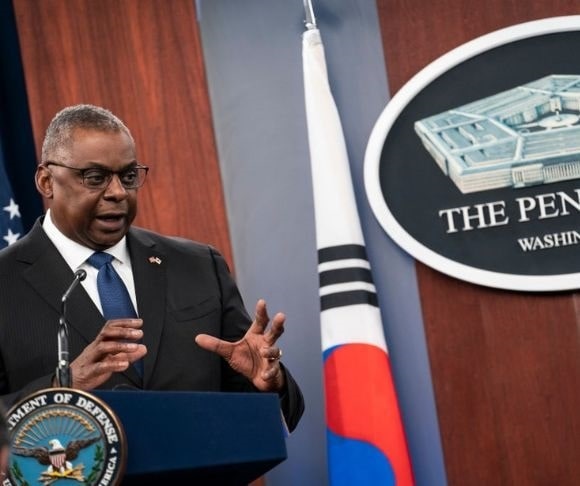On the evening of December 2, inspiring, anthem-like music announced the unveiling of America’s most advanced strategic bomber, the Northrop Grumman B-21 Raider. With a ghostly countenance, blue-white lighting silhouetted the flying wing fuselage draped in filmy fabric, the shimmering material pulling back to reveal the newest stealthy nuclear-capable aircraft in the US triad arsenal. Then the chocks were removed, and the Raider was slowly and dramatically towed from the cloaked-in-secrecy Plant 42 hanger. The stunning reveal was worthy of the most expansive of Hollywood productions. The premier of the bomber was heralded with pomp and speeches from the Air Force and Defense Department glitterati.
 Introducing Secretary of Defense Lloyd Austin III, Admiral Christopher C. Grady, vice chairman of the Joint Chief of Staff, told the assembled dignitaries and Northrop employees, “America’s bomber fleet is the globe’s premier, airborne, extended deterrent…to field long-range sensors and weapons.” During his time at the podium, Secretary Austin explained that the name “Raider” was in honor of the April 18, 1942, Doolittle bombing raid on Tokyo, Japan, just four months after the attack on Pearl Harbor. With just 16 B-25 medium bombers, Lieutenant Colonel Jimmy Doolittle and his band of 80 airmen flew over 650 miles from a US Navy carrier to demonstrate “the strength and the reach of American airpower.” Austin said, “Fifty years of low observable technology have gone into this aircraft. Even the most sophisticated air defense systems will struggle to detect the B-21 in the sky.”
Introducing Secretary of Defense Lloyd Austin III, Admiral Christopher C. Grady, vice chairman of the Joint Chief of Staff, told the assembled dignitaries and Northrop employees, “America’s bomber fleet is the globe’s premier, airborne, extended deterrent…to field long-range sensors and weapons.” During his time at the podium, Secretary Austin explained that the name “Raider” was in honor of the April 18, 1942, Doolittle bombing raid on Tokyo, Japan, just four months after the attack on Pearl Harbor. With just 16 B-25 medium bombers, Lieutenant Colonel Jimmy Doolittle and his band of 80 airmen flew over 650 miles from a US Navy carrier to demonstrate “the strength and the reach of American airpower.” Austin said, “Fifty years of low observable technology have gone into this aircraft. Even the most sophisticated air defense systems will struggle to detect the B-21 in the sky.”
The B-21 Raider program was awarded in 2015 to Northrop, beating out the Boeing-Lockheed Martin team of competitors. Valerie Insinna, writing for Breaking Defense, described the B-21 unveiling as a “once-in-a-generation rollout ceremony,” an unfortunate but true observation about the Defense Department’s interminable acquisition system. The program buy for the new bomber is 100 aircraft to replace both the B-1 Lancer and the B-2 Spirit, the legacy air-breathing jet aircraft coming to the end of their service lives. However, whether the B-52 Stratofortress, America’s oldest strategic long-range bomber, will ever leave operational service remains a mystery.
At first glance, the new bomber looks a lot like the B-2 stealth bomber first introduced over thirty years ago. But make no mistake, the capability the B-21 brings to America’s strategic force projection cannot be overstated. It is a sixth-generation bomber with stealth coatings, sensors, and precision targeting systems like no other. As Richard Aboulafia, an aerospace analyst with AeroDynamic Advisory, told Breaking Defense:
“In line with expectations, it looks a lot like a scaled down B-2, with a few modifications Most of the progress in aerospace over the last 35 years has been with subsystems, materials, and connectivity, so that makes sense. It’s interesting that the flying wing concept created in the 1940s is still relevant today.”

Lloyd Austin (Photo by Sarah Silbiger/Getty Images)
The B-21’s performance characteristics and mission systems capabilities are still highly classified, but some clues can be deduced as to improvements over the B-2. Brian Everstine, Pentagon editor for Aviation Week, described the apparent advancements in the B-21. There are “four key differences: shallower, tear-shaped inlets; a narrower fuselage crown with redesigned cockpit windows; a wider, deeper fuselage relative to wingspan; and two wheels on each main landing gear versus the B-2’s four,” Everstine explained.
These changes from the B-2 in external characteristics contribute to a more efficient airflow over the fuselage to improve lift-over-drag performance and enhance low-observable or stealth capability. In addition, the lighter gray color suggests new and improved coatings, significantly reducing the aircraft’s radar signature. Aspects of the plane that could not be seen and remain unknown are the number of engines and engine exhaust nozzles configuration, providing some evidence as to how the heat signature is dissipated.
When America puts its mind to something, extraordinary things happen. “The B-21 is a testament to the best of America’s vibrant and diverse industrial base,” Austin tweeted. “It’s this sort of advance that makes us great and this sort of advance doesn’t just happen. It takes investment. It takes cooperation. And it takes partnership.” Seven years from award to rollout is a significant accomplishment. Having the newest most capable sixth-generation long-range, stealthy nuclear penetrating bomber ever produced, creates a formidable addition to the triad of bombers, silo-based Intercontinental Ballistic Missiles, and submarine-launched atomic warheads. Our adversaries, particularly China, will, no doubt, take notice.
The views expressed are those of the author and not of any other affiliation.




